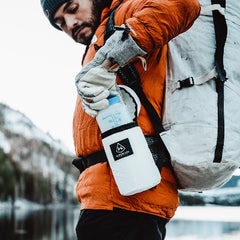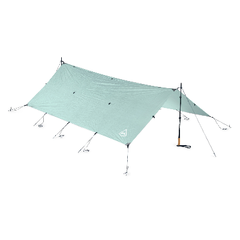Words & photos by Cody Townsend & Ian Provo
Maybe you heard that there’s a new member of the Hyperlite Mountain Gear pack family! The Headwall 55 is a backcountry ski pack for the chill people who work hard and put in long hours to get to the top, just to see it all go downhill. But they love it that way, and we’re happy to oblige them with some fresh gear for their pursuit.
A couple moons ago, we got to chatting with backcountry ski legend Cody Townsend. He was already familiar with our gear and had been heading out on adventures with one of our Porters for some time. He had a list of “you know what would be cool?” type features he wished his pack had, and we went to work taking notes, building prototypes, and sending him and some of our other accomplished snow sports friends out in the wild to test them out.
We asked Cody and longtime bud Ian Provo what backcountry skiing means to them and their people, and we thought we’d share some of their thoughts about this endeavor they’ve shaped so much of their lives around.
CODY TOWNSEND

So, to me, what I’m looking to get out of a day in the backcountry is entirely molded by the conditions. Skiing is an entirely condition-driven sport, and we hunt and ride those conditions like a surfer catching a wave with the wave then dictating how they ride. There are days when you wake up to two feet of snow in the driveway, it’s still dark, and you’re hustling to throw everything together and get out the door to race to the trailhead and get the deepest, freshest, and best run you can. On other days, it’s sunny, hasn’t snowed in weeks, and you’re going strictly to get your heart rate up, get your legs moving, and feel that sweet exercise-induced endorphin rush. Sometimes you want to get away from the madness of the ski resort and find peace in the trees. Some days, you look to the biggest, scariest, and most challenging lines in your neighborhood range, looking to tick off that dream line that has haunted you for years. I think the best and most passionate backcountry skiers are trying to flow with the weather, adapt to the conditions, and squeak the most out of any given day.

The perfect day? Well shit. I don’t even know what that is since my best memories on skis vary from summiting iconic peaks after days of suffering to perfect pow days with your buddies. That’s the great thing about skiing in my mind; it allows for such a wide array of emotions, expressions, and enjoyment. There are thousands of ways to enjoy yourself on a pair of skis and a lifetime to try and explore every aspect of the sport. But most likely, it would involve an empty trailhead, two feet of blower, stable pow, zero wind, cold in the shade, warmth in the sun, a few buddies, no rush, and lapping from sunrise to sunset. A lunch on the summit. Beers at the car at the end of the day. Laughs, smiles, hoots, and hollers.
To me, the best sensation and feeling in skiing is the weightlessness of hauling ass down a steep perfect powder run. It makes you feel almost superhuman. But with that, the emotions I want to feel to get to that point are confidence in the snowpack, familiarity with the environment, being in sync with my backcountry partners; fit, fast, and strong on the way up, and full of pure excitement as you click in and get ready to drop in.

Great equipment in skiing is equipment you forget about. It becomes an afterthought as it blends into you, goes weightless, and does nothing to annoy, hamper, or complicate your day. Great gear helps you keep your focus on the day, the conditions, the route, your team, and yourself.
IAN PROVO

I want to ride pow. I want the snow quality to be excellent. I don't want to see too many people, if any at all. I want to get some nice exercise. I want a thrilling descent. Or a mellow one. Depends on the day. Most importantly, I want to come home safe, so I can do it again and again.
The perfect day could be snowing, sunny, hot, or cold. Depends on the time of year. If we are talking about the perfect "powder day", then it should be cold and snowy. We don't want to see the sun. The sun warms up the snow and negatively affects its quality. We want the snow to be deep, dry, and light. We want our friends there to enjoy it with us. We want to push it a little. We want to ride big lines from top to bottom.

The emotions that play out, out there are feelings of wonder, awe, shock, excitement, reward. Those feelings are what keep us going back for more. There is a sense of self-sufficiency. A sense of pure freedom in that moment. There may also be moments of fear, unknown, and anxiety. Triumph.
While out in the backcountry, I want to feel safe, confident, and agile. I also want to feel loose and free, out on the edge, adventurous. It is necessary to find a balance between all those feelings and emotions. If you are just out there like a daredevil every day, you might get hurt or worse. In contrast, if you are too conservative, you may not reach your full potential.
Great equipment feels great. However, it is important to have shitty equipment at least once in your life. That way, you can really appreciate how good the equipment is. In backcountry skiing, your equipment is everything. It gets you to the top. It brings you down. It can save your life. I like my equipment for the mountains to be light and strong. Less is more. Light is right.
While we're out there, we're after the summit. We want to ski pow from the top to the bottom. We want to challenge ourselves. We want to connect with nature. We are searching for purpose. And in the mountains, we find all of those things.

I could write a novel about why we ski the backcountry. There are all sorts of reasons, but here are a few simple truths:
-
In Backcountry skiing, the "Headwall" refers to an appealing alpine feature that is ideal for shredding. It is generally steep, planar, and has its beginnings at the summit or along the flanks of a prominent mountain. ALWAYS, the goal is to ride the headwall from the top down. To take it from the top. Oftentimes, the only way to reach the top of a headwall is to climb directly up its face. The headwall is the objective.
-
Backcountry skiing requires you to "break your own trail." The mountains are covered in fresh snow, and you would like to ski down from the top. You must use climbing skins to cut a path through the deep snow. It is arduous, difficult, grueling, and absolutely rewarding work. It is best to have partners to help split up the work by swapping out the lead position when legs begin to tire. Sometimes the skin track has already been cut. This can be good or bad. Good because somebody has already done the hard work. Bad because they could be on your line. Break the trail, don't let the trail break you
-
People backcountry ski for lots of reasons. We do it for the experience on the way down. Flying down a mountain covered by a blanket of soft snow with boards attached to the feet is a thrilling thing to do. We will gladly spend hours, even days, or weeks, climbing and hiking up for one descent. The allure is so strong. The experience feels cosmic and mysterious.
-
The backcountry is free. Not exactly, but pretty close. You obviously need a fair amount of equipment–a good backpack, some outerwear, ski touring gear, and reasonable access to some snowy environments. But if you're able to secure those things, it's damn near free. With maybe just a few snacks for the day and some sweat equity, you are backcountry skiing. In comparison to the ski resorts of the world, it is a steal. The big corporations monopolizing the ski world are doing more damage than good. It is too damn expensive. It is no longer an activity accessible to working-class families. But anyone who wants to can do it. There are not too many rules. Find the freedom to express yourself.
To learn more about the Headwall 55, make your way over HERE.

















